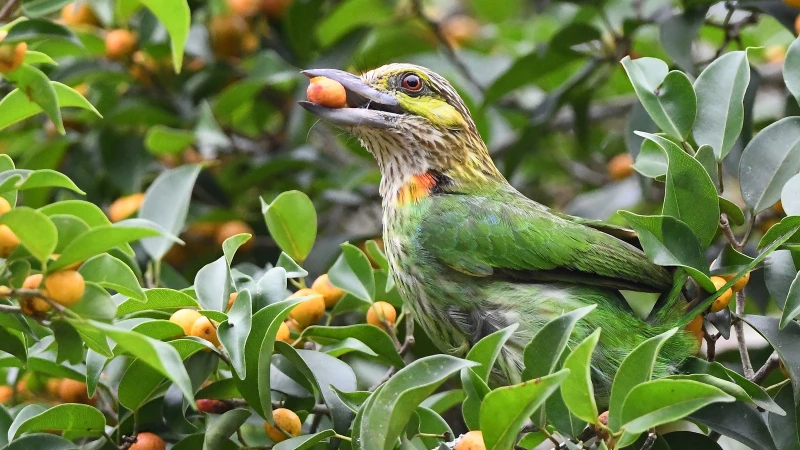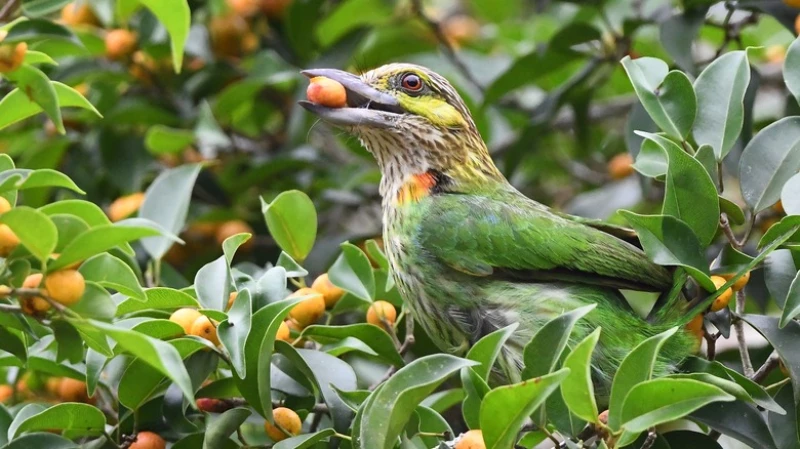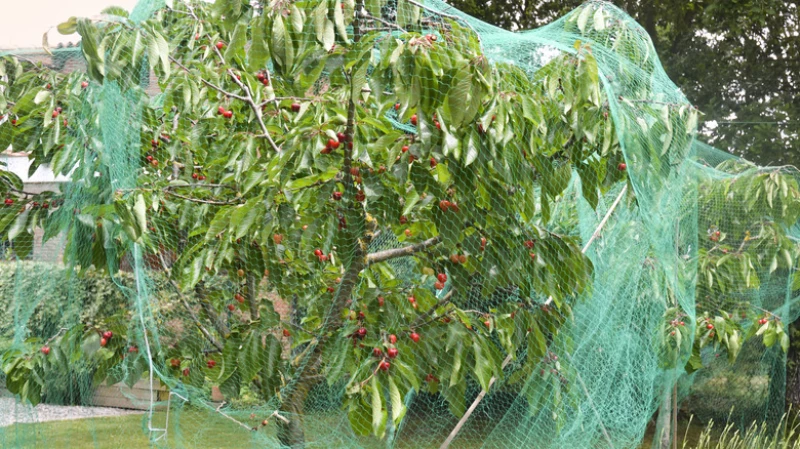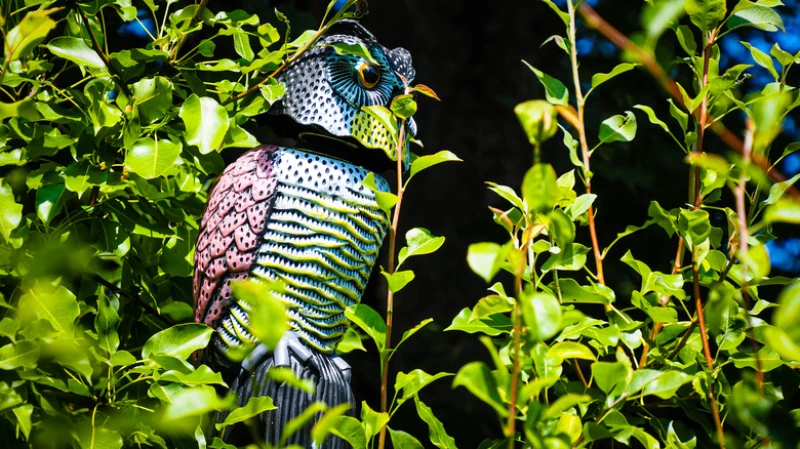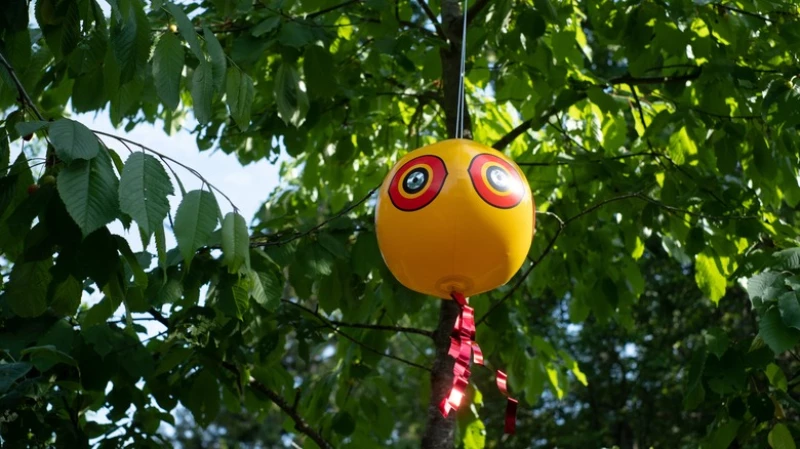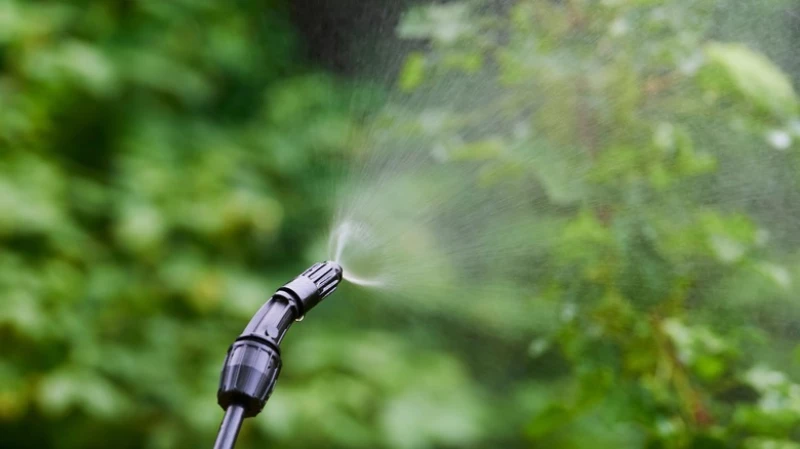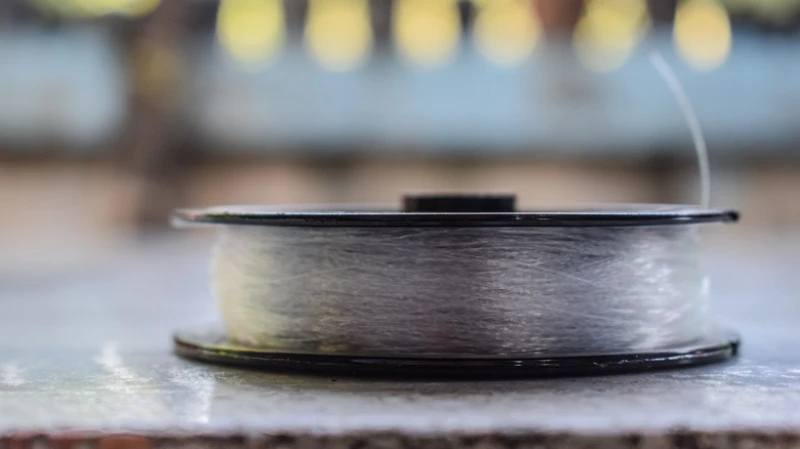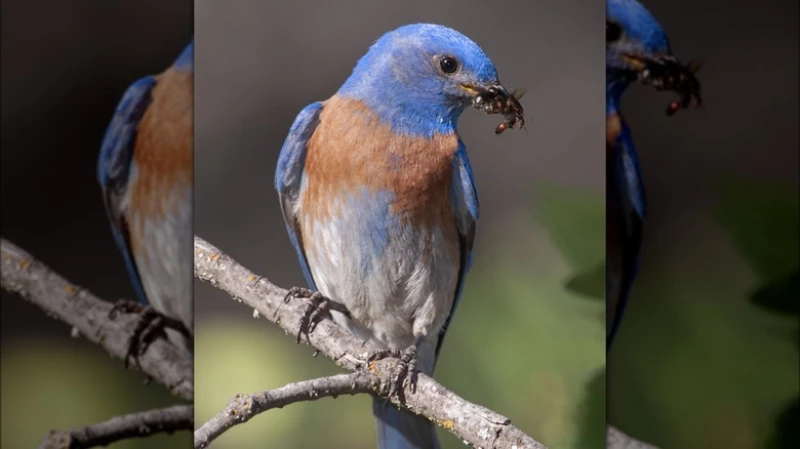Many gardeners enjoy the beauty of birds in their gardens. These colorful creatures bring life and charm to the landscape with their vibrant feathers and cheerful songs. They also provide a valuable service by eating weeds and insects. However, when the fruits in the garden ripen, birds can become a nuisance as they compete with gardeners for the literal fruits of their labor. They often leave behind half-eaten berries or, even worse, their droppings. While bird droppings can act as fertilizer, they can also be unsightly and inconvenient. Therefore, it is important to find ways to keep birds away from the garden.
Birds are adaptive creatures who switch their food preferences with the seasonally changing fruit profiles. They share a penchant for energy-giving lipids that grow in proportion to the fruits' maturity. They also love plucking off varieties high on anthocyanin, as they can see them better due to UV reflection. A winter food shortage can also cause these high flyers to peck dormant fruit buds. Regardless of the reasons, it's undeniable that your fruit trees need protection. Fortunately, there are multiple humane methods to deter birds from munching on your garden fruit. Netting, audio and visual scare devices, and repellent sprays are just a few. Use them in tandem for the best results.
Drape the fruity area in netting
Exclusionary techniques like casting a nylon net or row fabric over your short-statured fruit plants are the most effective way of keeping avian thieves away. After all, if the birds can't reach it, they can't eat it. To make this work, install the net on an elevated frame made of stakes or bamboo. Alternatively, leverage the adjoining fence posts or PVC pipes to hold the net. Ensure it covers the shrubs completely and tether it to the ground to keep it from blowing away. If required, use spacers to prevent it from touching the shrubbery, or the nibblers will use the net as a perch to chomp down on the fruits through the holes. But if you're feeling crafty, try a DIY dollar tree hack to keep birds out of your garden by repurposing your hula hoops.
Dazzle the birds away with reflective items
Like humans, birds, too, feel uncomfortable with arbitrary light flashes, and you can capitalize on this to move the feathered pests along. The best part, though? You already have what it takes to rid your garden of pesky birds. Rummage through your storage, dust off some old compact discs (CDs) you haven't listened to in a while, and hang them from strings at differing heights from the trees you want to protect. Placing them close together will give you an added advantage, as the wind will have them clinking randomly, spooking the birds. But if you've already disposed of these '90s remnants, look for items in your kitchen, like aluminum foil or pie pans. Either wrap parts of the tree with foil or punch a hole in the pans and dangle them as you would the CDs. These noisy deterrents will even send squirrels and other troublesome mammals packing.
Spook feathered thieves with faux predators
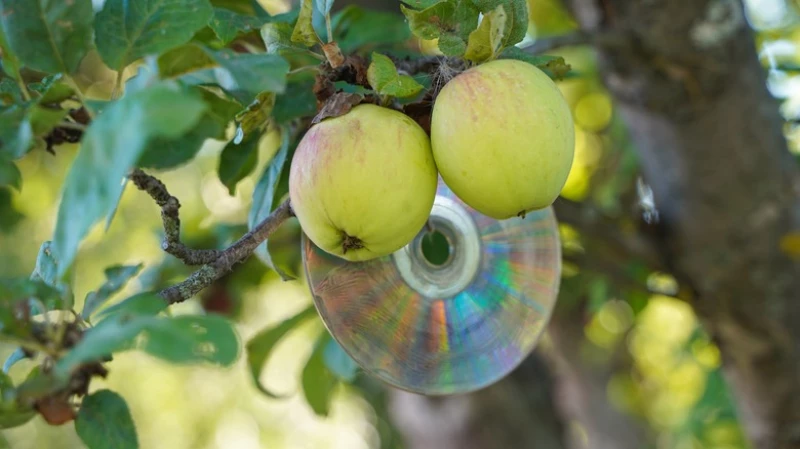
Alternatively, hang a reflective flash tape or Mylar streamers, especially if you're protecting cherries or apples. They're cheap and easy to use, albeit unattractive. However, they're unlikely to keep berry visitors like starlings, mockingbirds, house finches, and American robins at bay. Although the trick works well initially because the birds haven't made sense of the blinding reflections, the newness does wear off, and you may find birds using these items as a perch or weaved into their nests. But pairing the items with noisemakers can raise their impact.
The oldest trick in the bird-scaring book is to place scarecrows in your fruit orchard. While you can go old-school, with grain sacks and flannel pants adorning a human-shaped dummy, commercial options are available, too. Some variants are also equipped with a sound system and inflate irregularly to give the illusion of a living being, raising their deterrence level. But if scarecrows aren't to your liking, you can instead deploy static silhouettes of owls or snakes around your precious fruits — the bigger, the scarier. From plastic models to inflatable ones, they come armed with several imposing features, such as flappy wings and fidgeting heads that shock the unsuspecting foragers.
Startle the birds with balloons and kites
If you don't find decoys a worthwhile investment, try out the relatively inexpensive scare-eye balloons or balls with large holographic eyes drawn on them. Suspend them from the fruit trees or adjoining poles, and let the breeze handle the rest. If required, dangle the balloons with a spring to boost their erratic movements. Better yet, tether hawk- or falcon-shaped kites to the ground or hang them with helium balloons and leave the avian pests guessing if they've entered the zones controlled by the loathed birds of prey. In bigger orchards, arrange them so that there's at least one kite per hectare.
Sabotage the avian thievery through audio assault
As sirens, cannons, firecrackers, and exploders signal danger to the beaked bandits, they're usually the first choice for gardeners looking to deploy noise deterrents. But if they make you uncomfortable, there are more benign options, like recordings of distress and alarm calls that mimic the species or their predators. Solar or battery-powered noise devices are another option that may also feature flashy lights or motion sensors and are hung above trees. You'll need one system for every five acres for meaningful results. However, as these systems emit mechanical whirring sounds, birds soon learn to differentiate the noise, decreasing their effectiveness over time. They're also a bother in urban, populated areas, as they shrill early in the morning when the pecking pests are active. In such instances, ultrasonic systems are a better call, as they're usually inaudible, making them less intrusive.
Leave them baffled with spinning devices
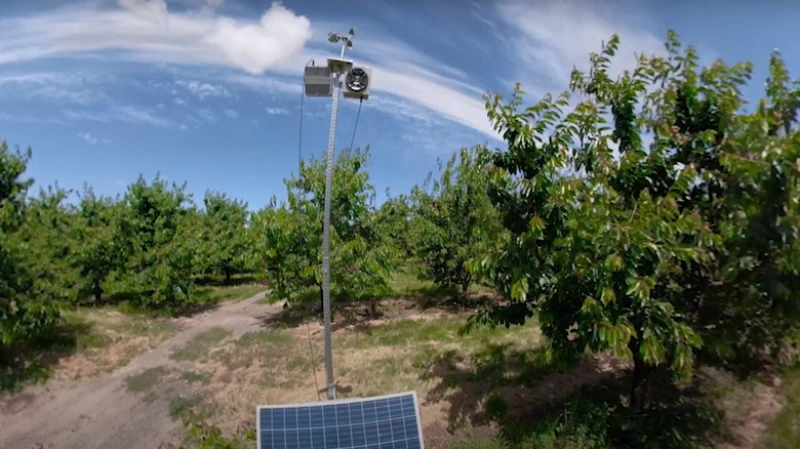
Looking for ways to deter birds from your garden fruit? Try using visual tactics like garden spinners, miniature pinwheels, and tiny windmills. These colorful and attractive devices not only add an ornamental touch to your garden but also confuse and deter birds from approaching your fruit. You can even make your own DIY wind spinner to add a personal touch. Place the spinners close to your fruit trees or on tall poles if the trees are large. Alternatively, you can use cheap pinwheels and snake decoys to create both visual and auditory deterrents.
Redirect their attention to alternate food sources
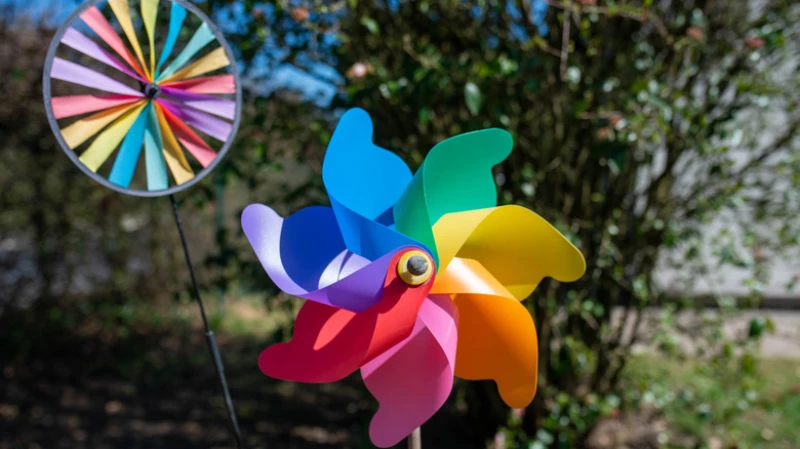
You might give this one a side-eye, but it truly works. The feathery visitors swoop down to nibble on fruits because they're hungry (no points for guesses). So, once you provide them with a more appetizing meal just right for their palate, why would they gorge on the juicy pulp instead? The easiest way out is to mount fully stocked bird feeders far away from your fruit trees. Plus, the benefits of having a bird feeder may become obvious, as you begin to enjoy birdwatching, easily restoring the symbiotic relationship between the flock and you. It could backfire, however, if you slack on refilling the feeder, leaving you with a group of famished critters that you attracted to your yard in the first place.
Repel Birds with Sprays
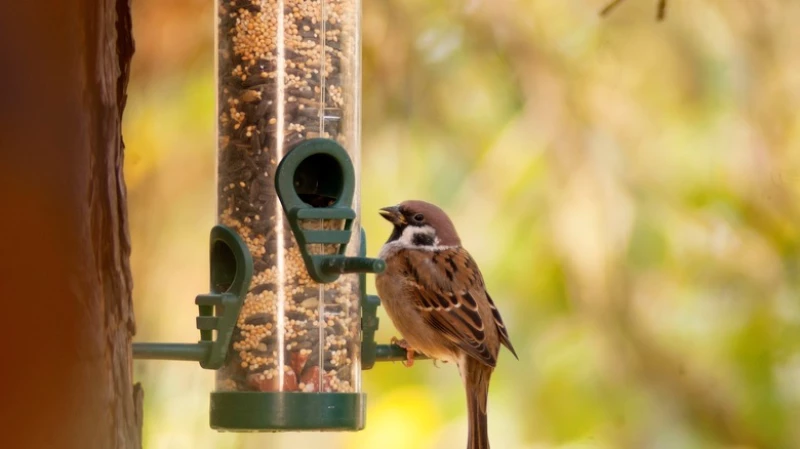
You can deter birds from stealing your fruits by using repellent sprays. These sprays contain chemicals that have unpleasant tastes and odors for birds. One effective repellent is Avian Control, which contains methyl anthranilate. Birds are irritated by contact with this ingredient, and it is also found in grape-flavored Kool-Aid, making it suitable for berry crops. However, using sprays alone may not be enough, so it's important to provide an alternate food source to distract the birds. Additionally, the sprays need to be reapplied regularly throughout the harvesting season to maintain their effectiveness. It's important to note that these sprays should not be used on blueberry crops as they can cause leaf scalding.
Send them flocking over fishing line
Another inexpensive yet highly effective method to lessen bird invasions is monofilament fishing lines, which are pretty easy to use. Just prop a pole near your fruit trees, ensuring it's at least 2 feet higher than the trees' tops. Attach a line to the pole and extend it to the ground. Repeat the process around the tree by spacing all lines 2 feet from each other into the soil. Stake them for a better hold. Your final structure should resemble a conical tent. As fishing lines are prone to intertwining, never place them directly over the branches. Don't worry if some branches sit outside the lines, since birds are unlikely to come within a foot of the structure.
Turn on the laser light
Beam strobe lights, spotlights, or flashing lights on your fruit bushes if hungry birds remain persistent. The lights are easy to install and need little maintenance, but they do require a convenient power source. Keep the flash frequency under 100 per second and use blue lights, as birds are more sensitive to their wavelengths. While the exact reasons for the lights' effectiveness remain unclear, some believe it has to do with unfamiliarity. Plus, they're fairly disorienting when shone during lowlight feeding times (dusk till dawn). Some birds may, however, become used to them over time.
Shorten avian visits through habitat management

While constantly searching for the best scaring ploys, it isn't unusual to lose sight of the pivotal role played by habitat quality and management in dispersing pesky birds. But then again, it requires quite a bit of planning and labor. The goal is to design the landscape in such a way that birds lose interest in engaging with it. Similar to your list of birds that you don't want to see in your yard, birds have their lists, too. So, making the garden habitable for bird-deterrent species is one way to keep the avian thieves away. For instance, many orchard owners succeed in putting up nest boxes for American kestrels that feed on fruit-eating birds. At the same time, you can deliberately invite specific bird species like purple martins and bluebirds that aren't as disruptive, perhaps because they stick to insects, while working to keep marauders like mockingbirds off your property.
Rearranging where you plant fruit shrubs bears fruit, too. As currently understood, the damage is more significant if the fruit trees are grown around the edges of a garden, especially next to rows of non-fruit vegetation. Replacing them with low-maintenance hedges around the borders is sure to make the birds lose interest sooner than you think. You can magnify the benefits further by using native trees in hedgerows, as they'll attract better pollinators and pest controllers. Whenever possible, switch to fruit varieties that your daily visitors find relatively unappetizing.
Plant vegetation that sends birds on a detour
You can have rowdy birds make a beeline for greener pastures by planting flowers they dislike. For instance, daffodils are a no-no for foraging fowl because of the toxic lycorine compound present in them. Thus, planting daffodils next to your fruits (if they aren't competing) can quickly bar the winged creatures' entry. Similarly, some bird varieties dislike white flowers, so having them around works. Curiously, despite their tasty fruit, blackberry plants throw some birds off, thanks to their spiky foliage. But avoid growing them if starlings and silvereyes visit your garden often. Also, experiment with bird-resistant cultivars. A 2012 study in Plant Production Science found a few sunflower varieties that were left relatively untouched by the tiny oriental greenfinch — their routine attacker — because they couldn't manage to eat the bigger seeds.
Ward off birds with wind chimes

Not all sounds need to be grating on the ear — as is the case with noisemakers and distress calls — for them to repel birds effectively. Sometimes, all you need to achieve your bird-frightening goals is a sweet-sounding wind chime. Hang them around your treasured trees after carefully removing most (if not all) of the perch spots that birds love to sit on. This means cutting back certain branches and moving bird feeders to another location. You can also place them in your yard's corners by hooking them to a pole.
Birds are not fans of chiming sounds, unlike humans. They would rather flee from your fruit garden to escape the annoyance. However, they can become desensitized to the sound over time. To achieve better results, try hanging larger wind chimes with louder tones that deeply irritate the birds. Additionally, choose chimes with shiny, metallic, or reflective surfaces to provide a visual element. These surfaces will create flashes of light that serve as an extra warning to the birds. If you are repurposing old wind chimes, consider covering them with reflective tape. Keep in mind that wind chimes rely on the wind to be effective, so make sure your area is adequately breezy. Otherwise, there is no point in having them. Lastly, move the wind chimes around every few days until you have harvested all the ripe fruits.

